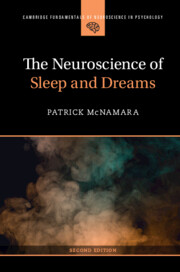Book contents
- The Neuroscience of Sleep and Dreams
- Cambridge Fundamentals of Neuroscience in Psychology
- The Neuroscience of Sleep and Dreams
- Copyright page
- Dedication
- Contents
- Figures
- Tables
- Preface
- Acknowledgments
- Chapter One What Is Sleep?
- Part I Sleep
- Chapter Two From Biological Rhythms to the Sleep Cycle
- Chapter Three Expression of Sleep across the Human Lifespan
- Chapter Four Characteristics of REM and NREM Sleep
- Chapter Five Sleep Disorders
- Chapter Six Theories of REM and NREM Sleep
- Part II Dreams
- References
- Index
- References
Chapter Four - Characteristics of REM and NREM Sleep
from Part I - Sleep
Published online by Cambridge University Press: 06 April 2023
- The Neuroscience of Sleep and Dreams
- Cambridge Fundamentals of Neuroscience in Psychology
- The Neuroscience of Sleep and Dreams
- Copyright page
- Dedication
- Contents
- Figures
- Tables
- Preface
- Acknowledgments
- Chapter One What Is Sleep?
- Part I Sleep
- Chapter Two From Biological Rhythms to the Sleep Cycle
- Chapter Three Expression of Sleep across the Human Lifespan
- Chapter Four Characteristics of REM and NREM Sleep
- Chapter Five Sleep Disorders
- Chapter Six Theories of REM and NREM Sleep
- Part II Dreams
- References
- Index
- References
Summary
If we want to know about the neurobiology of sleep, we need to very briefly summarize the main features of the neurobiology of wakefulness. In Figure 4.1 the main components of the networks that activate and maintain wakefulness are diagrammed. Two major pathways are shown in Figure 4.1. One (in yellow), rooted in the ascending reticular activating system (ARAS), shows that activating impulses ascend from ARAS via the via the thalamic-relay nuclei as well as reticular nucleus of the thalamus. This input is coming from acetylcholine (ACh)-producing neuronal groups, which are located in the Pedunculopontine and laterodorsal tegmental (PPT/LDT) nuclei of brainstem. The second major group of neurons (in red) are located in noradrenergic (NA) locus coeruleus (LC), serotoninergic (5-HT) dorsal and median raphe nuclei, dopaminergic (DA) periaqueductal gray matter (vPAG), and histaminergic (His) tuberomamillary neurons (TMN). The largely cholinergic groups are in mutual inhibitory balance with the large aminergic sertoniergic/noradrenergic groups. Additional cortical input also originates from the GABA or Ach neurotransmitter containing basal forebrain (BF) neurons as well as from lateral hypothalamic (LH) peptidergic neurons that contain the melanin-concentrating hormone (MCH) or orexin (hypocretin) (ORX).
- Type
- Chapter
- Information
- The Neuroscience of Sleep and Dreams , pp. 70 - 84Publisher: Cambridge University PressPrint publication year: 2023

